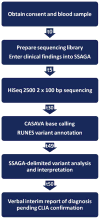Rapid whole-genome sequencing for genetic disease diagnosis in neonatal intensive care units
- PMID: 23035047
- PMCID: PMC4283791
- DOI: 10.1126/scitranslmed.3004041
Rapid whole-genome sequencing for genetic disease diagnosis in neonatal intensive care units
Abstract
Monogenic diseases are frequent causes of neonatal morbidity and mortality, and disease presentations are often undifferentiated at birth. More than 3500 monogenic diseases have been characterized, but clinical testing is available for only some of them and many feature clinical and genetic heterogeneity. Hence, an immense unmet need exists for improved molecular diagnosis in infants. Because disease progression is extremely rapid, albeit heterogeneous, in newborns, molecular diagnoses must occur quickly to be relevant for clinical decision-making. We describe 50-hour differential diagnosis of genetic disorders by whole-genome sequencing (WGS) that features automated bioinformatic analysis and is intended to be a prototype for use in neonatal intensive care units. Retrospective 50-hour WGS identified known molecular diagnoses in two children. Prospective WGS disclosed potential molecular diagnosis of a severe GJB2-related skin disease in one neonate; BRAT1-related lethal neonatal rigidity and multifocal seizure syndrome in another infant; identified BCL9L as a novel, recessive visceral heterotaxy gene (HTX6) in a pedigree; and ruled out known candidate genes in one infant. Sequencing of parents or affected siblings expedited the identification of disease genes in prospective cases. Thus, rapid WGS can potentially broaden and foreshorten differential diagnosis, resulting in fewer empirical treatments and faster progression to genetic and prognostic counseling.
Conflict of interest statement
Figures



References
-
- Green ED, Guyer MS. National Human Genome Research Institute, Charting a course for genomic medicine from base pairs to bedside. Nature. 2011;470:204–213. - PubMed
Publication types
MeSH terms
Substances
Grants and funding
LinkOut - more resources
Full Text Sources
Other Literature Sources
Medical
Molecular Biology Databases

